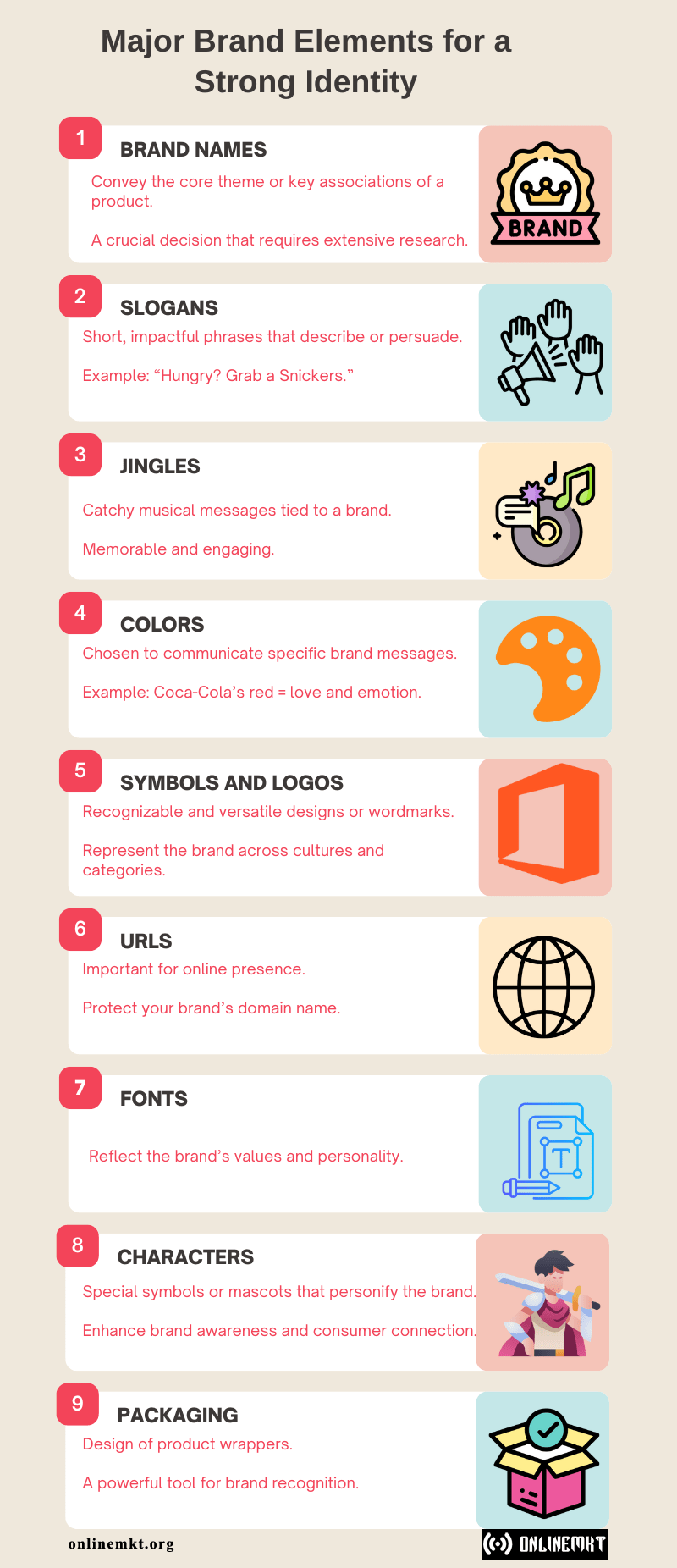Brand Elements

What makes a brand instantly recognizable? It’s more than just a logo! Explore the powerful brand elements that shape customer perception.
Brand elements are the core components that shape how a company is perceived in the marketplace. These include the brand name, logo, tagline, fonts, character, and colors. Each element plays a vital role in creating a unique identity that resonates with consumers. For example, the golden arches of McDonald’s evoke feelings of familiarity and comfort. Thoughtfully crafting these elements allows businesses to establish a strong emotional connection with their audience, making their brand memorable and trustworthy.
Consistency is crucial when it comes to brand elements. A cohesive brand experience across platforms—whether on social media, packaging, or advertising—reinforces recognition and builds loyalty. Imagine walking into a store and seeing the same colors and logos you’ve encountered online; it creates a sense of belonging. Companies that maintain this consistency stand out in a crowded marketplace and foster deeper relationships with customers. In today’s fast-paced world, strong brand elements can make the difference between a fleeting glance and lasting loyalty.
Brand Element Selection Criteria
There are six criteria used to choose brand elements. The first three—memorable, meaningful, and likable—focus on building the brand. The last three—transferable, adaptable, and protectable—focus on preserving brand equity and leveraging it against future challenges.
- Memorable: How easy is it for consumers to remember and recognize the brand element? Brands like Coke, Pepsi, Amazon, PayPal, Google, and Facebook have elements that are easily remembered.
- Meaningful: Is the brand element believable and representative of the product or target audience? Consider names like SpaceX, Blue Origin, Mastercard, and YouTube.
- Likable: How visually appealing is the brand element? Trendy names with URLs are popular for online brands, such as Flickr, Instagram, Pinterest, and Tumblr.
- Transferable: Can the brand element introduce products in different categories? Amazon started as an online bookseller, but its name allows it to expand into various product categories.
- Adaptable: How adaptable and flexible is the brand element? Shell’s logo, for instance, has been updated 10 times in the past 100 years.
- Protectable: How legally and competitively protected is the brand element? Names like Kleenex, Kitty Litter, and Jell-O need to be protected from becoming generic.
Brand Element Options
Your brand communicates who and what you are. Here are some of the most important brand elements for creating a lasting brand identity:
- Brand Names: A good brand name conveys the core theme or key associations of a product quickly. It’s an important decision that marketers cannot change often, and extensive research is usually done before making a choice.
- Slogans: Short phrases that convey descriptive or persuasive information about a brand. Slogans like Snickers’ “Hungry? Grab a Snickers” are powerful branding tools.
- Jingles: Musical messages that revolve around a brand. Their catchy hooks can make them almost permanently memorable.
- Colors: Brand colors are carefully chosen to convey specific messages. For example, Coca-Cola’s red signifies love and emotion, while Starbucks’ green represents nature and individuality.
- Symbols and Logos: Logos can be wordmarks or abstract designs that are easily recognizable and versatile across cultures and product categories.
- URLs: Domain names are important for a company’s online presence. Protecting your brand’s URL from unauthorized use is crucial.
- Fonts: The fonts used by a brand help convey its values and personality.
- Characters: Special brand symbols that can take on real-life or human characteristics, helping to create brand awareness and connect with consumers on a personal level.
- Packaging: Packaging involves creating the wrappers for products and can be a powerful tool for brand recognition.
Conclusion
Brand elements are the building blocks that define your business’s identity and shape how customers perceive you. From your logo and color palette to your tagline and typography, each element plays a crucial role in creating a memorable and cohesive brand experience. By carefully designing and consistently applying these elements, you can foster trust and loyalty among your audience, setting your brand apart in a crowded marketplace.
Investing time and effort into developing strong brand elements is not just about aesthetics; it’s about storytelling and connection. When your brand elements resonate with your target audience, they create an emotional bond that encourages engagement and advocacy. Embrace the power of these elements, and watch your brand flourish as it captures hearts and minds.